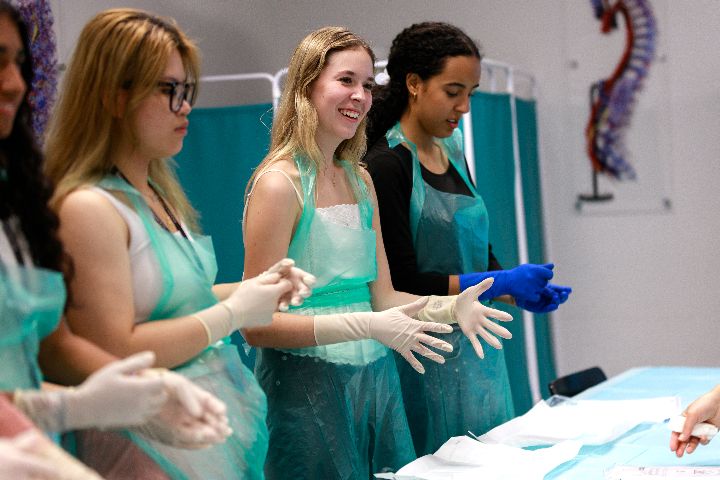2024 Spring/Summer Online Research Symposium Runner Up – Cecilia P
Each season, we select insightful, well-researched and original research projects completed as part of our Online Research Programme to present in our Symposium. Our Spring/Summer 2024 Symposium runner up is Cecilia P, who presented research on the role of stem cells in the female reproductive system.
Her paper can be read below. Access her presentation slides here.
Introduction to stem cells and the female reproductive tract
Stem cells, characterized by their unique ability to self-renew and differentiate into various cell types, hold the potential to revolutionize medical treatments and deepen our understanding of human development. More specifically, stem cells are human cells which have the capability to develop into a range of different cell types such as muscle cells and brain cells, even potentially fixing damaged tissues.
The Waddington landscape indicates this process as it is a diagrammatic representation of the natural restriction of cell differentiation during normal development of how a cell progresses from an undifferentiated state to a differentiated state during this process. They can be divided into two main categories: embryonic stem cells and adult stem cells.
Embryonic stem cells are characterized as pluripotent which means that they can turn into more than one type of cell, whereas adult stem cells are more likely to generated only certain types of cells, although induced pluripotent stem cells are a possibility where adult stem cells change in the lab to behave like embryonic stem cells. In these two vast categories, stem cells can be often split into several sub-categories based on their “potency”, or in other words their capacity to give rise to similar cell types, for example, pluripotent, totipotent and multipotent.
The first is able to give rise to all cell types in an adult, the second to all embryonic and adult lineages and the third to multiple cells within a lineage. Such lineages are able to occur when the embryo undergoes a process called “gastrulation” shortly after fertilization which subdivides the cells into three layers which are referred to as the embryonic germ layers and are the: endoderm (the cells of internal organs), the mesoderm (muscles and the blood) and the ectoderm (the nervous system and epithelial layers).
Furthermore, embryonic tissues are classified as extra-embryonic (“outside the embryo” referring usually to the cells of the amniotic sac and the placenta which are discarded after birth) and embryonic. Therefore, when classifying stem cells, a multipotent stem cell must make at least two different lineages from the same embryonic germ layer, pluripotent stem cells can make multiple lineages from all three embryonic germ layers but not extra-embryonic tissue and totipotent stem cells can use all embryonic germ layers and the extraembryonic tissue.
Stem cells play a pivotal role in women’s health and embryology, offering invaluable insights into reproductive processes and potential therapeutic interventions. They are integral to the maintenance and regeneration of tissues throughout the reproductive system by contributing to the regeneration of the endometrium, repairing damaged ovarian tissue and ultimately forming the structures of the developing fetus. However, stem cell use in research often faces numerous challenges such as ethical issues of using embryonic stem cells, hard to grow adult pluripotent stem cells and rejection of the body of foreign embryonic stem cells.
The journey of the egg through the female reproductive tract provides a captivating framework for exploring the multifaceted role of stem cells in women’s health and embryology. From the maturation of the egg within the ovarian follicle to its fertilization and implantation in the uterus, stem cells contribute to each stage of this intricate process. By investigating the involvement of stem cells in different segments of the female reproductive system, this research aims to unravel their significance in the body.
The ovaries contain stem cells that can give rise to oocytes and failure of these stem cells can cause Ovarian Cancer and Premature Ovarian Failure.

Firstly, ovaries, being a pair of female glands in which eggs form, are the primary home of an egg cell; although the presence of stem cells in the ovaries remains controversial. On the one side, studies and research carried out hint at the possibility of there being stem cells in the ovaries. Johnson et al demonstrated that through the isolation of adult mouse and human ovary cells, oocyte-like structures can be formed which are incorporated into follicles where oocytes could be generated in ovaries by putative germ cells (undifferentiated cells that possess the ability of pluripotency and self-replication) in bone marrow and peripheral blood.
The Ddx4 antibody was used in immunofluorescence analysis whereby mouse oocytes were found to not show evidence of cell surface expression although it was proved that they are a contaminating cell type in both adult mouse and human ovaries. More particularly, mouse oogonial stem cells were able to generate functional eggs after intraovarian transplantation. White et al isolated GSCs (glioblastoma stem cells which have similar characteristics to tumors) using fluorescence-activated cell sorting which also used Ddx4 antibodies to obtain GSCs free of oocytes, although it is speculated that these may be somatic stem cells and not GSCs. Ovarian stem cells have been shown to exist although the presence of GSCs has not been demonstrated. Equally, critical commentaries argue against the possibility of postnatal de novo oogenesis. In a study by Gould et al, follicles were counted in both primordial follicles as well as initial primordial follicles with germline stem cells, reaching an observation of 4-6 months. The results described decreases in follicles over time and the stem cell model failed to describe the changes that they observed in the follicles over time.
Another study used Ddx4 expressing cells from postnatal mouse ovaries which were found to not enter mitosis or contribute to oocytes, providing evidence that no post-natal follicular renewal occurs in mammals and that there are no mitotically active Ddx4 expressing female germline stem cells.
A similar study indicated that the genes required for meiosis are expressed only in the adult testis and fetal ovary of 23W, where adult ovaries exhibited lower levels in the expression of OCT3/4 and SPC3, showing how genes associated with meiosis are abundant in fetal ovaries but absent in adult ovaries, therefore indicating that such stem cells are present in embryos only.
Finally, the programmed cyst breakdown in mouse ovaries is unaffected by Foxo3 deficiency revealing that the timing of cyst breakdown is identical in both Foxo3 +/+ and -/- ovaries.
Overall, it remains unclear if stem cells are in fact present or absent in the ovaries; although both sides seem to provide strong evidence which however has its limitations. In spite of the generally accepted dogma that the total number of follicles and oocytes is established in human ovaries during the fetal period of life, this new evidence challenges this understanding, and therefore the possibility of postnatal de novo oogenesis would be remarkable for vulnerable sectors in our society such as older aged women in gestation. Regardless, it is widely accepted that failure of such stem cells would be detrimental for the health of the ovaries but most importantly of the woman. The hallmarks of cancer, being: sustaining proliferative signaling,
Evading growth suppressors, resisting cell death, enabling replicative immortality, inducing angiogenesis, activating invasion, and metastasis are the six biological capabilities acquired during the development of human tumors, which are strangely similar to those of stem cells. The cancer stem cell theory proposes that cancer arises from normal stem cells, usually determined by the acquisition of damage in the stem cells during division, whose accumulation generates CSCs (cancer stem cells) responsible for tumor formation. According to this theory, cell division is crucial not only for tumor growth but also for the malignant transformation of normal stem cells, which is why understanding carcinogenesis remains of utmost importance.
Ovarian Cancer and Premature Ovarian Failure (POF)
Ovarian cancer occurs when abnormal cells in the ovary grow and divide uncontrollably, eventually forming a tumor that can spread to other areas of the body through the abdominal cavity, between the ovaries and the fallopian tubes, following the retrograde menstruation theory. Moreover, Premature Ovarian Failure (POF), also known as premature ovarian insufficiency, can result from a depletion of ovarian follicles. This leads to ovaries not making the typical amounts of the hormone estrogen or releasing eggs regularly, leading to infertility and hormonal imbalances.
Stem Cells in the Fallopian Tubes and Ectopic Pregnancy
The role of stem cells in the fallopian tubes involves the replenishing of damaged epithelial cells, which contribute to ectopic pregnancy. As the egg is released from the ovaries, its journey through the fallopian tubes, an important passageway to the uterus, has been found to contain stem cells. In a study by Snegovskikh et al., stem cells have been localized and distributed in the epithelial and smooth muscle layer of the murine oviduct using the LRC approach (showing the location of replication). The fallopian tube also has a pool of stem cells available for repair and regeneration processes.
Within the epithelium, a subset of stem cells demonstrates remarkable plasticity, contributing to the continuous regeneration of the tubal epithelial lining. These cells play a crucial role in replenishing damaged epithelial cells, ensuring the functionality of the tubal mucosa (tissue that nourishes the moving oocyte or zygote). Complementary to epithelial stem cells, stromal stem cells within the fallopian tube stroma also play a vital role in tissue maintenance and repair. These stromal stem cells contribute to the dynamic remodeling of the tubal stroma, facilitating structural support and epithelial-stromal interactions essential for tubal physiology.
In ectopic pregnancy, interactions between fallopian tube stem cells and embryonic cells contribute to the implantation of embryos outside the uterine cavity, leading to potentially life-threatening complications. Additionally, stem cell alterations have been associated with tubal disorders such as hydrosalpinx, salpingitis, and tubal scarring. Finally, Paik et al. have demonstrated that the stem-like epithelial cells in the distal fallopian tube are expanded in precancerous lesions of the tube and in the tubes of women with ovarian cancer.
Uterine Stem Cells in Menstrual Cycle Maintenance and Gynecological Disorders
The uterus’ stem cells maintain the menstrual cycle and support pregnancy, yet they can also give rise to endometriosis, adenomyosis, leiomyomas, and Asherman’s syndrome. As the egg moves through the reproductive system to the uterus, the endometrium— a layer of tissue that lines the uterus, shedding about 400 times throughout a woman’s reproductive life during a menstrual period through glandular cells that make secretions— and the myometrium, which is the middle and thickest layer of the uterine wall, contain stem cells essential for uterine lining regeneration during the menstrual cycle and after childbirth. Epithelial, mesenchymal, and endothelial stem cells are present in these two layers of the uterus, maintaining the menstrual cycle and supporting pregnancy. However, these cells have also been implicated in the development of common benign gynecological disorders, including leiomyomas, endometriosis, and adenomyosis.
According to a research review by Testuo Maruyama, the location of stem cells in the endometrium can be clearly demonstrated through the following gland that secretes hormones, showing stem cells in three categories of stromal stem cells (mainly modulating inflammation) and four categories of epithelial stem cells (responsible for normal tissue renewal or regeneration following damage).
The Role of Placenta and Umbilical Stem Cells in Pregnancy Complications
As the egg cells fertilize and eventually form a placenta and umbilical cord, these stem cells have emerged in regenerative medicine and tissue engineering. Placental stem cells share similarities with embryonic stem cells and possess the capacity to differentiate into various cell types, making them valuable for therapeutic applications. However, abnormalities in the differentiation or function of placental stem cells have been implicated in pregnancy complications, such as placenta accreta and placental insufficiency. Umbilical stem cells derived from umbilical cord blood offer immense therapeutic potential due to their multipotent nature and immunomodulatory properties. These stem cells have been explored in various clinical settings, including regenerative medicine and transplantation. Furthermore, umbilical stem cells hold promise for mitigating complications associated with placental dysfunction by offering a readily available and non-invasive source of regenerative cells.
Placenta accreta, characterized by abnormal placental attachment to the uterine wall, poses significant risks of maternal hemorrhage during childbirth. Recent research suggests that dysregulation in placental stem cell differentiation or function may underlie this condition. Specifically, aberrant signaling pathways governing the invasive properties of placental stem cells could contribute to their excessive infiltration into the uterine wall, leading to placenta accreta. Investigating the molecular mechanisms underlying placental stem cell behavior in placenta accreta holds promise for identifying targeted interventions to mitigate its risks.
Cervical Stem Cells and Their Contribution to Cervical Cancer
Stem cells in the cervix maintain the structural integrity and functionality of the cervical epithelium. However, disturbances in the regulation of cervical stem cells can lead to pathological conditions, including cervical cancer. Cervical cancer typically arises from the transformation of normal cervical cells into malignant ones, often triggered by persistent infection with high-risk strains of human papillomavirus (HPV). Dysregulation of cervical stem cells may contribute to the initiation and progression of cervical cancer by promoting aberrant cell proliferation, impairing DNA repair mechanisms, and facilitating the acquisition of invasive and metastatic properties. Moreover, alterations in the microenvironment surrounding cervical stem cells, such as chronic inflammation and hormonal imbalances, can further exacerbate their dysfunctional behavior and promote tumorigenesis.
Summary of Stem Cells in the Female Reproductive Tract and Future Ideas
In conclusion, this essay highlights the pivotal role of stem cells in the biology of the female reproductive tract, encompassing the ovaries, fallopian tubes, endometrium, placenta, and cervix. Stem cells within these tissues contribute significantly to their development, maintenance, and regeneration throughout a woman’s lifespan. Moving forward, innovative regenerative medicine approaches hold immense promise for harnessing the therapeutic potential of stem cells in treating these conditions. Ideas such as induced pluripotent stem cells offer a groundbreaking discovery for generating patient-specific stem cell lines, facilitating personalized regenerative therapies. Treatment strategies involving the replacement, inhibition, or modulation of stem cells could revolutionize the management of reproductive disorders by promoting tissue repair and regeneration. Additionally, interventions targeting neoogenesis or therapies aimed at depleting or altering the differentiation and self-renewal abilities of stem cells could offer new therapeutic ways to restore reproductive health. Embracing these future ideas in regenerative medicine highlights the transformative potential of stem cell-based therapies to revolutionize the field of female reproductive health and advance personalized treatment strategies tailored to the unique needs of each individual patient.
Join the Immerse Education 2025 Essay Competition
Follow the instructions to write and submit your best essay for a chance to be awarded a 100% scholarship.


























